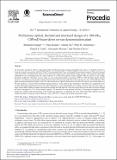Preliminary Optical, Thermal and Structural Design of a 100 kWth CSPonD Beam-down On-sun Demonstration Plant
Author(s)
Grange, Benjamin; Kumar, Vikas; Armstrong, Peter R.; Codd, Daniel S.; Calvet, Nicolas; Gil Pujol, Antoni; Slocum, Alexander H; ... Show more Show less
Download1-s2.0-S1876610215011273-main.pdf (1.383Mb)
PUBLISHER_CC
Publisher with Creative Commons License
Creative Commons Attribution
Terms of use
Metadata
Show full item recordAbstract
An innovative concept in which a single-tank molten salt thermal energy storage arrangement also acts as a volumetric receiver is being developed in connection with the CSPonD[superscript 2] (Concentrated Solar Power on Demand Demonstration) project. The tank is located at the focal point of a beam-down tower to act as both solar energy receiver and thermal energy storage. The relatively small angle subtended by rays emanating from the central reflector of a beam down optical system, together with the nature of solar energy absorption within the volumetric receiver, make use of a compound parabolic concentrator (CPC) or CPC-like final optical element attractive. An effective concentration of about 4 can be achieved to increase solar flux at the tank aperture from 150 to 600 suns. This paper describes preliminary designs of the CPC and tank/receiver. Optical simulations reveal that, for a given solar incident power at the tank aperture, a conical final concentrator design produces a more uniform flux distribution with better axial alignment (lower average horizontal component) of rays at its outlet compared to a conventional CPC of revolution. However the cone may require a
larger outlet radius, leading to higher thermal losses through the tank aperture. With the current design of the tank, the losses through the walls correspond to 5.5 % of the thermal capacity. To maximize the tank thermal efficiency, a thorough investigation will be carried out, starting with measurements of the molten salt emissivity, to determine the cone outlet radius/tank aperture and cone height that achieve maximum system efficiency with a 250-550 °C molten salt working temperature range. Keywords: Thermal energy storage; Concentrated solar power; Molten salt; Thermocline; Beam-down tower; CPC, Cone, Ray-tracing.
Date issued
2015-08Department
Massachusetts Institute of Technology. Department of Mechanical EngineeringJournal
Energy Procedia
Publisher
Elsevier BV
Citation
Grange, Benjamin, Vikas Kumar, Antoni Gil, Peter R. Armstrong, Daniel S. Codd, Alexander Slocum, and Nicolas Calvet. “Preliminary Optical, Thermal and Structural Design of a 100 kWth CSPonD Beam-down On-Sun Demonstration Plant.” Energy Procedia 75 (August 2015): 2163–2168. © 2015 The Authors
Version: Final published version
ISSN
1876-6102